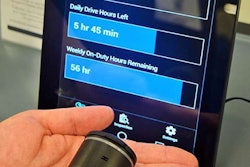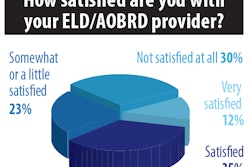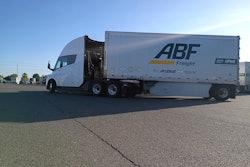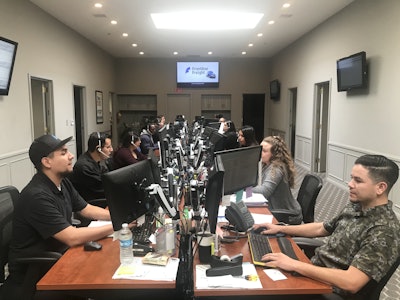 LTL carriers, like Frontline Freight based in Industry, Calif., are utilizing Carrier Logistics’ FACTS software to automate pickup and delivery dispatch activity.
LTL carriers, like Frontline Freight based in Industry, Calif., are utilizing Carrier Logistics’ FACTS software to automate pickup and delivery dispatch activity.Whether you’re a shipper, freight broker or motor carrier, freight matching is the linchpin of business profitability. Even minor mistakes are costly given the value of time and the expense of labor, fuel and equipment.
Traditionally, only businesses with significant IT resources and density in their freight networks would invest in advanced software to optimally match freight with capacity.
Recent developments have leveled the playing field, giving companies of all sizes new, affordable options that tap the power of machine learning and cloud computing to make better load planning decisions.
Top-level consolidation
Transportation management software (TMS) has always been the foundation of freight matching technology in the supply chain, starting with shippers and third-party logistics providers.
When RoxAnne Thomas joined Woodridge, Ill.-based Gerber Plumbing as a transportation manager in 2018, the company had not used a TMS for planning its approximately 25 truckload shipments of plumbing fixtures per day to customers across the United States from three — and soon to be four — distribution centers.
Gerber’s load planners were using spreadsheets and homegrown tools to build truckload, less-than-truckload and parcel shipments for daily customer orders. The tools lacked the capabilities to evaluate different cost-saving scenarios, she says.
In some instances it might be more costly to ship two orders on a truckload with two delivery stops than to ship the orders separately via LTL. Those types of calculations were difficult to do manually, Thomas says.
In January 2019, Thomas led the implementation of a cloud-based system from 3Gtms to automate the load planning process. The 3Gtms system receives orders directly from the company’s Oracle ERP software and uses algorithms to determine optimal loads by consolidating freight into truckloads to meet the promised delivery date for its customers, which generally is within two weeks of orders.
Since using 3Gtms, the company has significantly reduced its transportation spend on LTL and parcel carriers by doing “everything possible to optimize into truckload,” she says.
![Optym developed a TMS for smaller truckload fleets, Axele, to help them keep up with digital brokers who are “making it harder [for carriers] to make any money,” says Ronda Lewis, chief revenue officer of Optym.](https://img.ccjdigital.com/files/base/randallreilly/all/image/2019/10/ccj.LoadSelection-2019-10-18-12-42.png?auto=format%2Ccompress&fit=max&q=70&w=400) Optym developed a TMS for smaller truckload fleets, Axele, to help them keep up with digital brokers who are “making it harder [for carriers] to make any money,” says Ronda Lewis, chief revenue officer of Optym.
Optym developed a TMS for smaller truckload fleets, Axele, to help them keep up with digital brokers who are “making it harder [for carriers] to make any money,” says Ronda Lewis, chief revenue officer of Optym.
Shippers with private fleets are always looking for better ways to utilize their own assets. BOLT Software, a TMS provider for motor carriers, recently worked with one of its private fleet customers and ELD partners to create a Load Pooling feature that lets drivers automatically check for a load originating out of their current “circle of opportunity.”
The feature was designed to give drivers a list of options to stay productive after making an assigned delivery. Instead of returning to a distribution facility with time left on their hours-of-service clocks, they can log into their ELD and ask for a particular type of load or a load that is ready to go.
The Load Pooling process is designed to minimize dispatchers’ direct involvement and still provide drivers with the essential information needed to complete their tasks, as well as provide detailed information regarding trailer/container tracking and key freight arrivals and departures, the company says.
BOLT describes the new feature as “driver self-dispatch.” Drivers can be provided with a pick list of pool loads organized by priority and volume. A driver logs in and requests the highest priority outbound pool load, and if the selected load is not available, continues the selection process. After the driver’s request is received, the current highest priority outbound load is sent to the driver.
Optimization for carriers
Motor carriers are also using new cloud-based TMS systems with built-in optimization tools to make better freight matching decisions. Some of the systems are now tapping into machine learning technology.
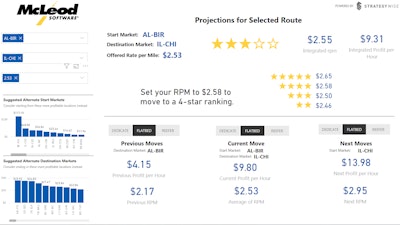 TopOrder from McLeod Software gives carriers a dashboard to evaluate “forward profitability,” the profit per hour, of every order and lane.
TopOrder from McLeod Software gives carriers a dashboard to evaluate “forward profitability,” the profit per hour, of every order and lane.Optym recently launched a web-based TMS for small to medium-sized truckload carriers. The system, Axele, builds on the company’s footprint in the less-than-truckload sector where it has been optimizing linehauls for more than a decade.
The company saw an opportunity to bring optimization technology to smaller fleets in the truckload sector to help them keep up with digital brokers who are “making it harder [for carriers] to make any money,” says Ronda Lewis, chief revenue officer of Optym.
The Axele TMS can evaluate and identify the most profitable loads for carriers in the spot market, she says. The system integrates with load boards to find freight combinations that will create the best profitability per day. The system accounts for rates, hours-of-service and other variables and integrates with electronic logging devices (ELD), she says.
McLeod Software recently developed a new predictive scoring system for its fleet customers to evaluate orders in its LoadMaster TMS platform. McLeod partnered with a Birmingham, Ala.-based data science company to develop the scoring that rates each load on a 5-star scale.
The system, TopOrder, gives carriers a simple way to evaluate “forward profitability,” or the yield of orders, which is the profit per hour (Revenue – Cost)/Time of every order or lane.
The product will be rolled out in phases. The first release, which is available now, gives users a dashboard for evaluating the profitability of an order based on a carrier’s historical lane activity.
Through the dashboard, users can change the rate and the starting and ending markets for a load to see how that impacts the star ranking. For instance, if a user selects Birmingham to Arkansas, the dashboard will show what the next moves for the carrier will likely be from Arkansas to other markets. It will also show what the profit will be for the current and next move based on the rate.
 Keith Mader, Trimble Transportation’s vice president of data analytics, announced the new Dispatch Advisor tool at the in.sight user conference, Sept. 16
Keith Mader, Trimble Transportation’s vice president of data analytics, announced the new Dispatch Advisor tool at the in.sight user conference, Sept. 16Future developments will provide information on how carriers can increase the ranking for a load, says Jonathan May, director of business intelligence at McLeod Software.
In September, Trimble announced a new Dispatch Advisor product that gives fleets using Trimble enterprise transportation management software (TMS) platforms (TMW Suite, TruckMate or Innovative) a way to instantly see the best options for matching their loads with trucks.
The first version of Dispatch Advisor optimally matches loads with a single origin and destination to power units (a tractor with one or more drivers), said Chris Orban, vice president of data science.
The algorithm finds the minimum-cost combination of loads and trucks by using a cost matrix of time, distance, deadhead miles and other variables, Orban said, where “cost” is not necessarily a dollar value. A load that gets a driver home for the weekend, for example, may have a lower cost value than a load that does not.
The optimal recommendations for loads and tractors are fed directly into the load planning screens of the TMS systems. Users also get recommendations for the second, third, and fourth-best options (and more) with scores that show the reasons why.
By showing the next-best recommendations, users can account for human factors. A load planner may choose to go with the optimal solution for the easiest choices and use the recommendations to simplify the more complex decisions.
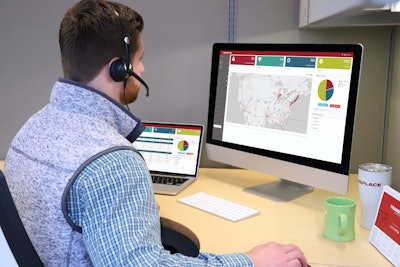 Transplace, a 3PL, uses machine learning software to identify “high probability outcomes” for loads when carriers go into areas to get lined up with outbound freight.
Transplace, a 3PL, uses machine learning software to identify “high probability outcomes” for loads when carriers go into areas to get lined up with outbound freight.“We order [the recommendations], so we show them which one we would like them to pick but we also have all the other options right below it,” said Keith Mader, Trimble Transportation’s vice president of analytics.
Choosing a sub-optimal recommendation may be necessary to “help or address how you treat drivers,” Mader said, because drivers have individual load and route preferences that the model can take into consideration.
To use the new product, Trimble customers need to have a modern version of TMS and pay for a license. Installation takes as little as one hour to have automated load planning recommendations, Orban said.
The speed of logistics
In addition to investing in new TMS technology, many transportation and logistics companies are making significant investments in digital apps that use machine learning to stay better connected with their business partners.
McLeod recently developed a Top Match module for its PowerBroker TMS system used by non-asset transportation and logistics companies. The module uses a machine learning algorithm that predicts the optimal and best-chance carrier to offer a load to.
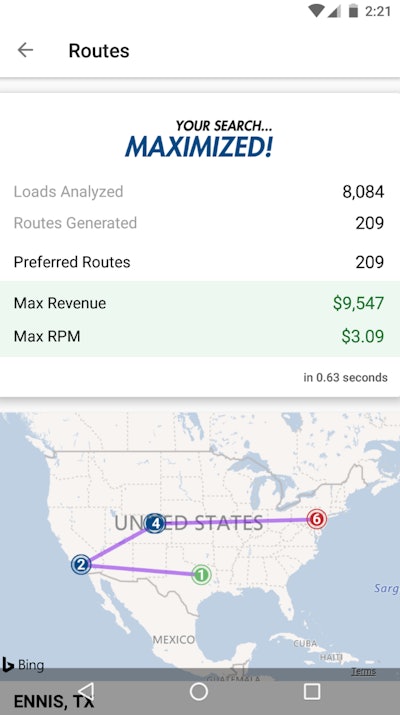 Landstar’s Maximizer app gives drivers trip planning information by showing the highest-paying loads out of origin and destination points.
Landstar’s Maximizer app gives drivers trip planning information by showing the highest-paying loads out of origin and destination points.Data inputs used by the Top Match algorithm include carrier lane history, load board integration and margin data.
In February 2018, Landstar rolled out a Maximizer app that is currently getting about 500 load searches per day from drivers. The app gives drivers trip planning information to help them maximize revenue by showing the highest-paying loads out of origin and destination points, says Rocco Davanzo, executive vice president of capacity development for Landstar Transportation Logistics.
The search engine in the Maximizer app looks at everything on Landstar’s load board and sends back the best revenue combinations.
A driver that searches for loads from his current location, such as Dallas, may see loads to Chicago may not be the best outbound rate, but see the rate selection out of Chicago is much better than at other destinations from Dallas, he says.
Drivers may already know which freight markets to avoid based on past experience, but the app trumps experience and intuition by keeping users up-to-date with fluctuations in rates.
The app does not give drivers a “Book it Now” option for loads. They have to call Landstar agents, but all loads listed in the search have a one-touch dial feature.
“I still think verbal dispatch is important,” he says.
For most of 2019, Transplace, a provider of transportation management services and logistics technology that manages $9 billion in freight spend, has used machine learning to do “capacity matching,” says Jim French, chief technology officer.
When freight is moving from point A to B, load planners at Transplace are able to look in advance for next-load opportunities for carriers to get them from point B back to A or to another destination, point C, he says.
The application uses machine learning to identify “high probability outcomes” for loads when carriers go into areas to get lined up with outbound freight.
“A large number of variables are influencing the outcome,” he says, and having fast predictions of freight at the destination has moved its load planning to the next level.
Machine learning is helpful to keep the freight matching algorithm up to date with a constant feedback loop, he explains, and to incorporate weather events.
“We are actively tracking risk to better identify loads facing weather events, well in advance,” he says.
Optimizing P&D routes
For LTL carriers, load optimization is not a freight and capacity matching problem. It is a time management problem.
Fleets that do local pickup and delivery have more work than can be accomplished given the time drivers have to complete their routes and return to a terminal to make the cutoff for linehaul operations, says Ben Wiesen, president of Carrier Logistics, Inc. (CLI).
As a TMS provider that focuses on the last-mile, LTL segment of the industry, CLI’s FACTS software has functionality for LTL carriers to effectively manage appointments for residential and commercial customers by scheduling pickups and deliveries for optimal time slots.
Wiesen says that CLI is using a mixture of data mining and AI technologies “to try and help carriers better plan the appointments.” In some cases, LTL carriers allow the customer to pick whatever times they want.
“What we are finding is that savvy LTL carriers are beginning to develop strategies. Some are further along than others,” he says.
Software can guide the appointment process to find the ideal time to make a pickup or delivery based on historical data and probability for “where trucks have been and when,” he says.
Algorithms can also find the average time it takes to service each zip code by the time of day, he explains. “We use that information to create a scoring system,” he says. With this scoring system, a fleet is able to proactively offer a customer an appointment time that would maximize operational efficiency.
At any level in the supply chain, from shippers to 3PLs and carriers, machine learning is changing the load planning process by delivering instant freight matching recommendations.
“We think machine learning and AI are the most-important information technology trends in the supply chain since the Internet and open connectivity. They are what give us the next leap forward,” says Transplace’s Jim French.






